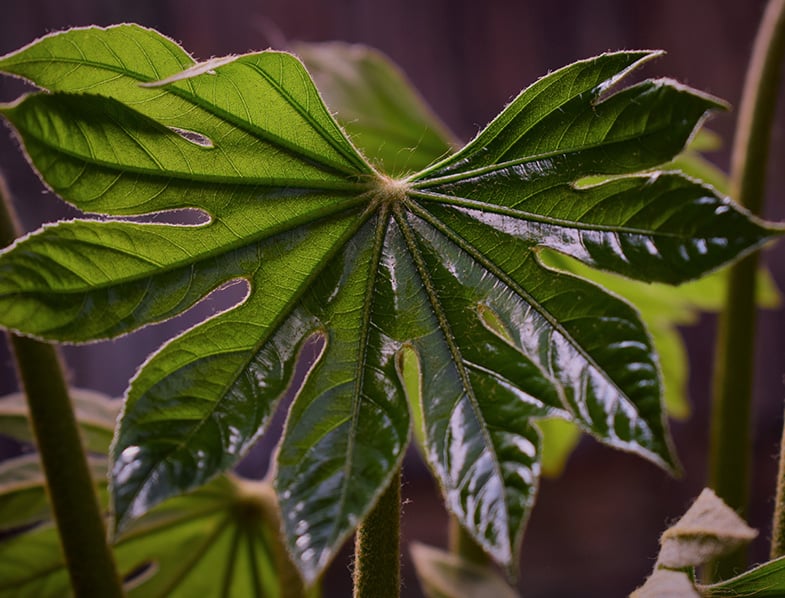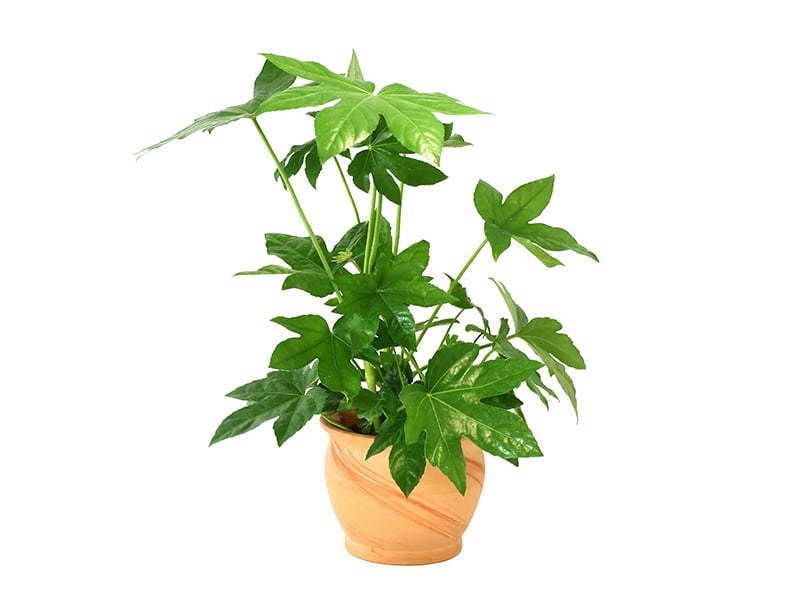The Japanese Aralia is a species of broad-leaved evergreen that is part of the Araliaceae family. Commonly referred to as the “Japanese Fatsia”, its official botanical name is Fatsia Japonica which means glossy-leaf paper plant.
The distinct leaves of the Japanese Aralia have also earned it nicknames such as “Castor Oil Plant” and “False Castor Oil Plant” because its foliage can be mistaken for that of the Ricinus – the real producer of castor bean.
Today, the Japanese Aralia is popular among most indoor plant owners and gardeners alike and is primarily grown as an ornamental plant that is able to grace and add a little bit of life to even the dullest and most rigid of interior spaces.
In fact, despite them growing along the coastal forests of Japan and Korea, these miniature trees are particularly captivating to the English. With the earliest scientific records dating back to the late 18th century, these plants were said to have been favored by the victorians and have since gained increasing popularity; so much so that it was granted the Royal Horticultural Society’s Award of Garden Merit.
Whether you are starting out in the practice of plantcare or have been around for some time, this subtropical shrub is a good choice as it grows fast and strong under the right conditions and is easy to care for at the same time. Indoor or outdoor, along windows or decorating the edges of verandas, with the right guidance, the Japanese Aralia will be your “go-to” for all purposes of ornamentation.
About the Japanese Aralia
Despite its name, Aralia is not actually native to Japan. It is grown around the world as a cultivated plant and was originally dispersed from Europe.
- One of the key characteristics of the plant are its huge, lobed leaves. The weight and bulk of the leaves often cause it to lean to a particular side. This can also be a good indicator or reference as to which part/s of the plant need pruning.
- While Aralia does have its cultivars, they are few and rare to find. Some of the most notable ones include the Anneise with its vibrant, emerald spotted and yellow sunny leaves; the Spider’s Web that’s characterized by web-like speckles and veins that dot its leaves; and the Moseri with its large, white floral blooms and black berries.
- The Aralia is a subtropical plant that prefers cooler temperatures and relatively average levels of humidity. Meant to thrive indoors, they should still be protected and kept from strong and cold drafts.
- The Aralia usually blooms during fall, or the equivalent time for more temperate regions, and develop clusters of bright, white flowers.
- With its large and lobed leaves, the Aralia is prone to being infested with pests. Check the leaves regularly for any signs of infestation from Spider Mites, Aphids, or Mealybugs. Treat immediately if you happen to spot any.

Japanese Aralia Features: An Overview
The Aralia is an upright plant and grows hardy in areas that conform to the conditions of USDA zones 7 to 9.
- Though mainly grown indoors as an ornamental plant, Aralia can be grown outside where they can reach a height of 16 feet. Inside, these plants still grow to a considerable 6 feet and be around 3 to 4 feet wide; their huge and leathery leaves can grow up to be a foot across.
- Despite being able to grow to an impressive size, the Aralia is surprisingly not that reliant on sunlight. It prefers areas of partial to full shade as bright, direct sunlight will bleach its leaves.
- This plant is a heavy drinker. Water regularly during the hotter seasons and cutback during the colder ones. The Aralia needs plenty of water so that it can maintain the lushness of its leaves. Make sure that the soil never runs dry and water until it gushes out of the container’s drainage holes.
- Remember that this plant prefers cooler temperatures. So long as temperatures don’t go below 7°C(45°F), the Aralia will be fine. Indoors, around 40% relative humidity will be ideal for it to continue to thrive.
- The Aralia likes neutral, slightly acidic compost-rich soil. Keep in mind the composition of the soil as it mainly prefers moist, but well-draining ones. Chalk, clay, and loam-soil are good choices.

Growing Japanese Aralia
Though the Aralia prefers cooler temperatures, this is once the plant has matured. If you plan to grow your Aralia from scratch, then the best time to do so would be in either spring or summer. Before you begin, decide carefully if you want to grow it indoors or outdoors.
After deciding on location, have it positioned in such a way that will make it receive sunlight, but not directly. Indoors, the ideal location would be just by the windows, same as how the ideal location outdoors would be under shaded patios or larger trees. Be sure to shelter them enough when growing outdoors as strong winds can also damage the leaves.
Once in place, the most hands-on task is watering. Aralia need regular watering just so that the soil stays moist at all times. For those that you decide to grow in containers or small pots, check on them regularly as they can quickly dry out.
- Fatsia Japonica Seeds, Japanese Aralia Seeds.
- New, Viable, Fresh, Legitimate, and Batch-tested and ready for immediate planting upon arrival!
- Japanese Aralia Seeds are beautiful, lush plants, native to Japan, Korea and China, that can provide a large plant spread of up to 6 feet indoors and 16 feet outdoors, adding to any jungle scene, indoor or outdoor!
- This large beautiful exotic sub-tropical plant, can aid any jungle scene in any environment, this hardy plant is also fast-growing! Are you wanting to get a a suitable amount of large plants for that budding indoor or outdoor jungle? Your new Japanese Aralia can get that problem solved really soon! Want some new plants than provide some great shade in the summer months? The Japanese Aralia is a perfectly suitable plant for such an idea!
- FREE SHIPPING on any additional products from our store !!!
- NAME(S): Japanese Fatsi / Paperplant / Japanese Aralia // SCIENTIFIC NAME: Fatsia Japonica syn. Aralia Japonica
- HARDINESS ZONE: 7 - 11 // BLOOM TIME: Flowers Late Summer - Mid Winter // Flowers turn to ornamental berries
- PLANT HEIGHT: 8 - 16' // PLANT SPACING: 10 - 12'
- LIGHT: Sun - Shade // WATER: Average // COLOR: White Flowers & Black Berries
- Amazon Kindle Edition
- Lalko, Andrey (Author)
- English (Publication Language)
- 53 Pages - 04/13/2023 (Publication Date)
Last update on 2024-01-21 / Affiliate links / Images from Amazon Product Advertising API
Follow this routine as consistently as you can up until the point that the climate starts to get colder. Once winter kicks in, cut back on your watering so that the plant can rest. The soil no longer needs to be moist as much, but still don’t let it dry out. For added nutrition and growth rate, also feed it with diluted liquid fertilizer.
Again, it’d be best to add fertilizer either before or after winter, once the danger of frost has passed – deciding to start growing in winter, though a bit more difficult, can still include adding fertilizer, but cutback on it to at least just once a month.
As mentioned. The Aralia, except for the constant watering, is overall an easy plant to grow and can do so at an astonishing rate of 8 to 12 inches a year given the proper care and under the right conditions.
Once your Aralia is grown, then pruning will now be an occasional event as you will need to prune it in order to keep it looking lively and to avoid having it lop over due to the immense weight of the leaves. This is also your indicator of whether it’s time to prune or not – once it begins to lean towards one side, then it’s time.
Follow these simple steps, and you’ll have yourself an award-winning Aralia in no time!
Watering Japanese Aralia
Since the Aralia naturally grows along coastal areas or near big bodies of water, the same can be said about its fondness of water. Remember that this plant is a heavy drinker and requires regular watering. Your soil composition will help determine the frequency of “regular” watering and can help you manage when and even how much water you’ll need to be able to have the soil moist. Never let the soil dry out.
As a general rule, water more during warm seasons and less during cold ones. Once everyday or every other day should be ample during spring and summer. Once a week or every two weeks should do in winter.
With big leaves, the Aralia is much less prone to “drowning” and root rot as its roots suck up large amounts of water to keep its leaves nourished and hydrated; in this case, one does not need to worry about saturating the plant with water.
Should there be a forecast of extended rain showers, then you can also make use of this by having your plant sit comfortably outside under partial cover, just so that it’ll get good amounts of water.

Propagating Japanese Aralia
You can propagate Japanese Aralia either via seed or stem cutting. However, chances are that the plant won’t bloom if grown indoors so the better option would be to go with stem cuttings.
To use this method, first cut off a stem from a mature plant early during the growing season (spring or summer). Next, place the cut stem in a pot or container filled with moist soil and cover it with a plastic bag.
Keep the cuttings in a warm and humid place until new growths emerge. Use a root hormone for a better chance of success. Overall, the cuttings should take root in about 1 to 2 months.
Aralia grow large and grow fast, so you might want to repot it at least once every year until it reaches its maximum size; don’t wait until it becomes too big for its current vessel or else you’ll have difficulty removing it due to the entanglement of its roots.
In Conclusion
The Aralia may not be an entirely beginner-friendly plant, but it’s one of the easier ones out there. Given their impressive size and commendable resistance, these plants are definitely a welcomed addition to any botanical collection.
Since these are mainly ornamental plants if grown indoors, then that only adds to the aesthetic options it can offer to help add to the atmosphere of your bedroom, kitchen, or even living room!
With the right amount of care, light, and a lot of water, the Aralia grows to be an imposing little tree that either greets visitors indoors, or towers over other plants staying guard in your front lawn or backyard.
Regardless of the circumstance, consider getting a Japanese Aralia; they’re are a good step-up for would-be plant enthusiasts as well as a much needed refresher and good daily for seasoned plant care practitioners.




2 Comments
Good guide on the Japanese Aralia. I”m planning to use this plant in my backyard soon!
I had a beautiful aralia in my previous home where I had acid soil. I moved it with me when we came here nine years ago and I have been moving it around the yard without success until this year. Suddenly it likes where it is and is growing rapidly. I was curious as to why it is suddenly happy with its surroundings so came here to see if soil was the problem all along. . It needed acidic soil and the soil here is VERY alkaline. It is happy now because it is near my camellia where the soil has been greatly altered to be more acidic. Now I know and I appreciate the info.